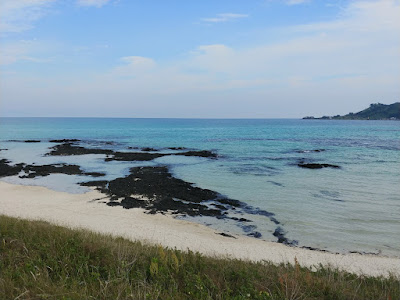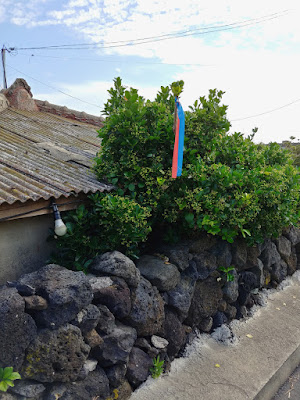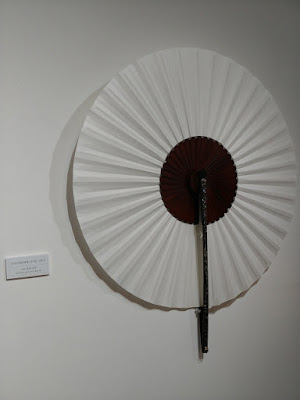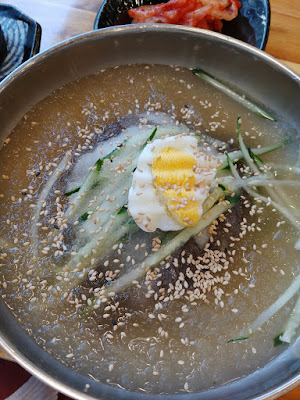Here she is again, anchoring me while traveling south to the gat exhibition hall.
Hard to see here but also visible from the main road where I stayed at Brenda's apt; I think I was in a rush to get to the bus stop so I didn't shoot from the better vantage point, but as I said, she's always there.
What was new was all the wind turbines. I get it, Jeju gets a lot of wind. But these are not attractive. They are all over parts of the coast as well. I feel like humans could have come up with a better design but it's probably too late for that.
I only noticed the solar panels for Yang Soon-ja's walk-in refrigeration unit in the picture behind the hanji! I was amazed that she had that unit right behind her house, and even more impressed by the mandarins she pulled out of there. She said the unit is so powerful that even though the fruit was a month or two old and the skin looked rotten and shriveled, the insides were fine. Of course she was right.
This shows what happens if the fabric folds over and is blocked from the sun: the color doesn't develop. I'm surprised more people haven't taken advantage of this with photo techniques (the way people do with cyanotypes) but maybe I haven't been looking very hard.
On my visit to Hyeopjae beach I saw the piled stones so particular to this place. I saw them on my first trip to Jeju in 2008 and it's always like seeing old friends.
There were tons of people camping out on the left of this path, which I found weird, and magpies were coming for me on the trail but it was still quiet as I visited around 7:30am.
Looking to the right was the sea, always soothing.
Tons of tents within these trees.
I visited Gwakji beach more often because it was closer and felt manageable. On one walk there, I saw this site of Airstream trailers parked as places to stay. Each one was numbered.So there'd be a sign, "Boy 123" or whatever. This seemed a little better than the tents and while I love the sea, I don't think I'd want to sleep right alongside of it. I grew up along a river and even though we were far from it, I still have recurring nightmares of it flooding all the way up to our home. Though these days with climate change, that is probably not unreasonable to fear.The Jeju Olle Trail is a way for people much fitter than me to walk the entire island. It's a series of connected trails and parts of my daily walks coincided with parts of the trail. This sign helps you know you're on the right path.
But these ribbons are also iconic of the trail, blue to represent the sea and orange to represent the mandarins. Tangerines? I really don't know how to classify them but in Korean they are called gyul.
Ribbons on the building at right.
And if you like to prove that you've done the trails, there are stations where you can stamp a passport.One of Gwakji beach's attractions is their fresh spring bath. They are divided into men's and women's sections, and I followed the directions of the signs, which said not to take pictures (as people could be there bathing naked). I had gone during my first visit to rinse my salty feet but was a little perturbed by an entire family that decided to go: father, mother, daughter, two sons. It was the first time that I realized that women's spaces are always considered free game to anyone. I doubt this family would have strode into the men's bath to frolic. Mother's always take their sons into public restrooms but I don't think fathers take their daughters to change diapers or whatnot. I can't even get into trans issues when it comes to these spaces but it did make me realize that we are conditioned from a young age to know that women's spaces are welcome to invasion.
This is the outside of the women's section, where the fresh spring water flows out and meets the salt water.
Being able to spend time here truly dissolved a lot of inner turmoil, though it roiled right back up once I returned to the mainland. They always say to try and return to the places that bring you the most peace, so I hope I can polish and imprint these memories. While translating for the movie project, Kang Mi-kyoung said that many haenyeo say that the sea is better than any man, any husband. You get love from the sea, money, and can take care of your whole family by harvesting.
Her kindness and generosity from the jump mirrored the way that Ms. Yang and Brenda took care of me in their own special ways, including me and giving me space to be alone. When I returned to the mainland, I realized that that is my trouble with staying in Jeonju: I have no friends here, no social life. It's all work, and that's why I always want to leave. So the balance is essential, and makes me grateful for all the friends I'll get to return to back home in a month.
Yet I am so grateful to be in a place where I don't have to worry about getting shot for no reason, and where even though I am not made up like everyone else, I still blend in in a way that I never can back home. An artist colleague recently wrote something that made me realize that it's not our invisibility solely that puts us in danger, but being highly visible/marked as "other." She said, "I am tired of the fact that I look different and stand out no matter how hard I try to act like the people around me. It is terrible because it makes me try to hide away and [be quiet]. Super visible + invisible existence! I am exhausted." This kind of thing makes me want all of my Korean and Korean American friends in the US to come hang out with me here. If not for the 2-week mandatory quarantine, it would be so much easier.
When I returned to Jeonju (I flew from Jeju to Gwangju, then took a cab to the bus terminal, and had to wait an hour or more as the next bus was sold out), I found out that my wifi was dead, which led me to a week of desperate calls and visits, from a dorm person to an IT person to the store that sold me my router to a mart that sold me an adapter cable and back to the IT person. I almost got on a train to Seoul just to use the wifi on the train and hotel (yes, I could use the office wifi but it's not the same as being able to type in a comfy place wearing whatever you want). While I know a lot of hanji vocab, I do not know any network/computer/etc. words. Even when I went to buy my router, I asked if that word meant building. HAHAA. I still can't tell you what the word for router is but I was grateful that the IT person was so patient and polite. The yucca outside the office was flowering when I returned!
Because all of the wifi stuff took so much time and energy, I wasn't able to do much else until the weekend. This is the nature of living in another country and taking care of basic survival needs (I know, it's sad to think of wifi as one of those but I was truly so relieved when the lights went back on and the internet started to work again on my devices): everything takes longer than it would for a native. Yet, I persist. I had missed a fan exhibit at the fan culture center in Jeonju, and loved this piece in the permanent exhibit part of the hall, a piece by Eom Ju-won (1938–2004), who was a provincial ICPH in North Jeolla Province of making fans, designated in 1997. I was mostly curious about the material for the outer ribs, which would be the only things visible when the fan is closed.
The special exhibit is a father/son show of the national ICPH of fan making (and the only one), Kim Dong-sik and his son, Kim Dae-seong, who has been so helpful with getting me bamboo processing knives and sharpening them for me. As well as cluing me into the fact that I can do a lot of my work more easily now if I let go of the old ways and also just look for stuff online. I loved this picture of them!
Kim Dae-seong's work, the son. I love love love the bat design on each of these bamboo pieces.
The father's particularly wonderful work, on a more rare fan shape, used to block the sun. Not only does he have to burn in the designs on the long bars but he has to choose the right bamboo that has many close nodes (usually that's not desirable for bamboo work but in this case, it is, for design's sake).
This was lunch that I had at a department store on a rainy and windy day when I knew I had to have soft food after getting my temporary tooth glued back in (I had accidentally knocked it out while inadvertently flossing, and of course it happened the night before the dentist's day off, so I had to wait a bit to go back. Of course I had cleaned it and stuck it back on in the meantime). Fried tofu skins are stuffed with seasoned rice and then topped with all kinds of decadence. I also had the sense on the way to the dentist to hop out of the cab early because I noticed the cab driver falling asleep in the rearview mirror and not responding to basic traffic signals or cars honking at him at the green light.
After my fan visit, I wanted initially to go to one place for dinner but it was closed, so I backtracked to a cafe that claimed it had real chocolate cake for sale (it's not that easy to get really good chocolate anything here). Sadly, they were already sold out but I was so sweaty and spent that I settled for this gorgeous black sesame cake. While eating it, I wondered what I actually wanted for dinner, and it was something a little different.
It wasn't this, I just got this in case the main dish wasn't enough food. This kimbap was so spicy and I didn't realize until I almost finished it that it's because there were raw spicy peppers inside. I was a little embarrassed to be eating so much food when other people only ordered the next dish, but I was feeling famished (yes, even after cake).
What I've realized is that even though I can't navigate like a local, I am skilled and resourceful enough to get by. Unlike my older relatives who can't deal with phone apps (partly because of their eyesight, which is something I am dreading), I use Kakao Map all the time and basically searched for a place that had good naengmyeon (cold noodles). It was thankfully within walking distance and it was great! The reason I ordered more than this is that my experience of noodles is that I become hungry about an hour after I've eaten them.
Because all of the wifi stuff took so much time and energy, I wasn't able to do much else until the weekend. This is the nature of living in another country and taking care of basic survival needs (I know, it's sad to think of wifi as one of those but I was truly so relieved when the lights went back on and the internet started to work again on my devices): everything takes longer than it would for a native. Yet, I persist. I had missed a fan exhibit at the fan culture center in Jeonju, and loved this piece in the permanent exhibit part of the hall, a piece by Eom Ju-won (1938–2004), who was a provincial ICPH in North Jeolla Province of making fans, designated in 1997. I was mostly curious about the material for the outer ribs, which would be the only things visible when the fan is closed.
The special exhibit is a father/son show of the national ICPH of fan making (and the only one), Kim Dong-sik and his son, Kim Dae-seong, who has been so helpful with getting me bamboo processing knives and sharpening them for me. As well as cluing me into the fact that I can do a lot of my work more easily now if I let go of the old ways and also just look for stuff online. I loved this picture of them!
Father
Father and son
Son (and the only son, which makes it more remarkable that he decided to take on this work full time).Their family lineage of fan makers
Kim Dong-sik's work, the father's
I think this is a detail of one of his fans but I didn't take good notes (I was so sweaty and dehydrated from getting there on a hot day after a light and early lunch). But each of these designs is burned into each piece of bamboo.Kim Dae-seong's work, the son. I love love love the bat design on each of these bamboo pieces.
The father's particularly wonderful work, on a more rare fan shape, used to block the sun. Not only does he have to burn in the designs on the long bars but he has to choose the right bamboo that has many close nodes (usually that's not desirable for bamboo work but in this case, it is, for design's sake).
The son's work. Again, the bats!
Back to the father. I have wanted these fans since I've seen them, and in a way it worked out that the jerk who first showed them to me wouldn't sell them, because now I have two that he has never touched. I was so sweaty after I left that I took one out immediately to start using. Very effective! I hope before I leave to have one more meeting/meal with Kim Dae-seong to talk about the ideal paper weight and quality and dimensions so that I can produce some paper good enough to send to him to make some custom work in the future.This was lunch that I had at a department store on a rainy and windy day when I knew I had to have soft food after getting my temporary tooth glued back in (I had accidentally knocked it out while inadvertently flossing, and of course it happened the night before the dentist's day off, so I had to wait a bit to go back. Of course I had cleaned it and stuck it back on in the meantime). Fried tofu skins are stuffed with seasoned rice and then topped with all kinds of decadence. I also had the sense on the way to the dentist to hop out of the cab early because I noticed the cab driver falling asleep in the rearview mirror and not responding to basic traffic signals or cars honking at him at the green light.
After my fan visit, I wanted initially to go to one place for dinner but it was closed, so I backtracked to a cafe that claimed it had real chocolate cake for sale (it's not that easy to get really good chocolate anything here). Sadly, they were already sold out but I was so sweaty and spent that I settled for this gorgeous black sesame cake. While eating it, I wondered what I actually wanted for dinner, and it was something a little different.
It wasn't this, I just got this in case the main dish wasn't enough food. This kimbap was so spicy and I didn't realize until I almost finished it that it's because there were raw spicy peppers inside. I was a little embarrassed to be eating so much food when other people only ordered the next dish, but I was feeling famished (yes, even after cake).
What I've realized is that even though I can't navigate like a local, I am skilled and resourceful enough to get by. Unlike my older relatives who can't deal with phone apps (partly because of their eyesight, which is something I am dreading), I use Kakao Map all the time and basically searched for a place that had good naengmyeon (cold noodles). It was thankfully within walking distance and it was great! The reason I ordered more than this is that my experience of noodles is that I become hungry about an hour after I've eaten them.
On the way home, I saw this cat, who clearly OWNS the entire area. It will sit in spots that are directly in the path of people and not move an inch, while all the kids run down the stairs and walk around. I have a lot to learn from this creature. Meanwhile, I am jealous of everyone here and back home planting diligently, including the folks in Virginia at Oak Spring Garden Foundation. One of their farmers, Caitlin, had interviewed me last summer during my residency, and posted her insights here.
Today was my 10th dentist visit in Korea and hopefully my last for this trip, but you never know, so I might have to visit one more time in a couple of weeks. Fingers crossed that the worst is over! Why so many posts all at once? Because true to my inability to stay in any one place for longer than a week, I hit the road early tomorrow morning to start bonus hanji study with the new national treasure and his apprentice. I haven't done this kind of work in a long time and hope my body is up to it. Here's to the final 30 days.

























































































